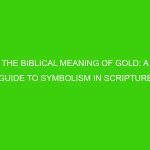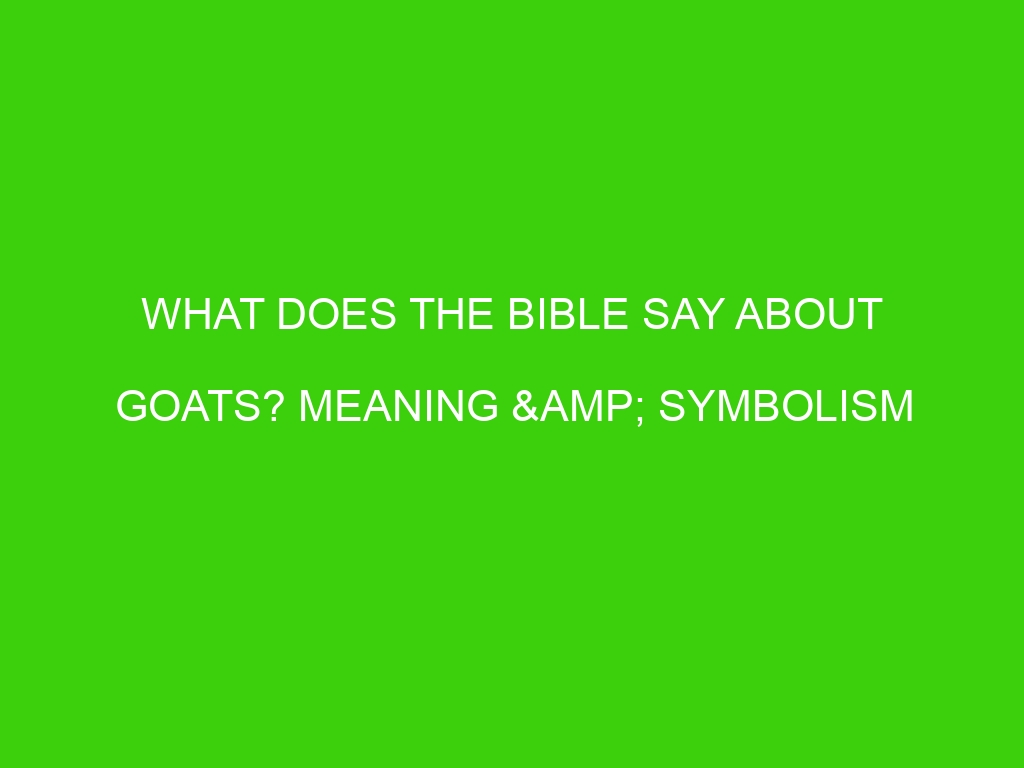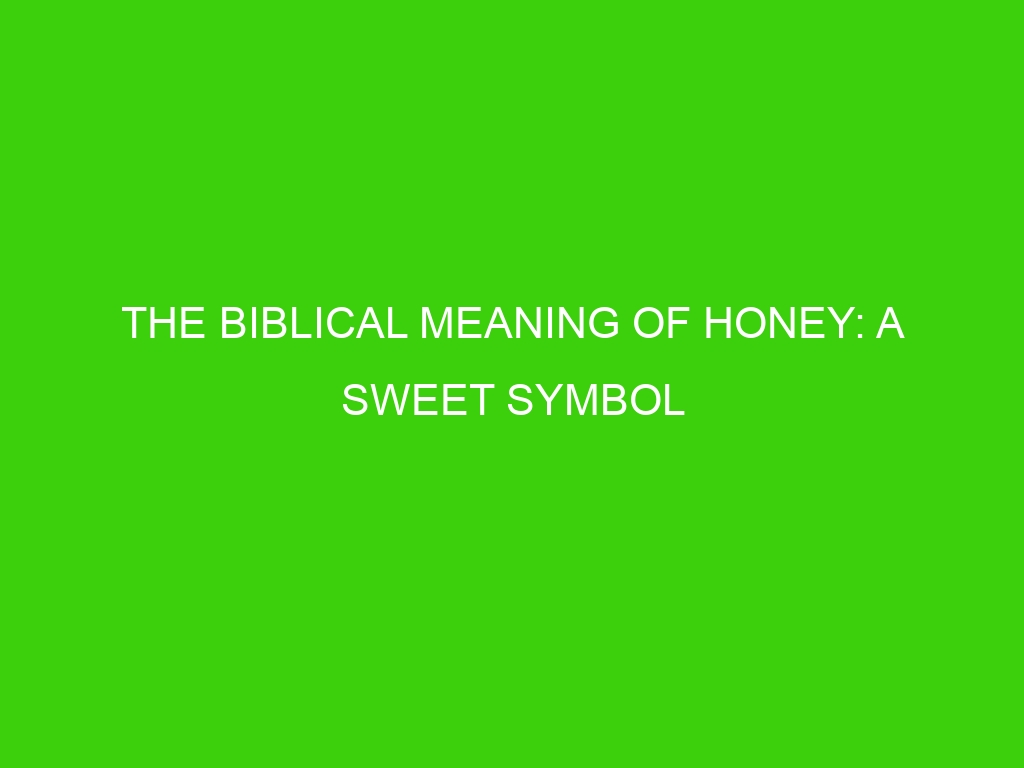Have you ever wondered what the Bible says about goats? As a livestock animal domesticated and raised around the world, the goat has taken on special meaning and symbolism in biblical texts.
With over 400 mentions throughout the Old and New Testaments, the goat plays an important role.
In this article, we’ll explore the significance of goats in biblical stories and what they represented to the ancient Israelites.
From sacrifice to sin, goats had layered symbolism in biblical times.
We’ll look at some of the most famous biblical goats like the scapegoat and Passover goat.
Understanding the biblical goat gives insight into ancient cultures and beliefs.
You may be surprised by the prominence of this humble farm animal in scripture and what its presence signifies.
Let’s dive into the biblical world of goats.
Goats in the Bible: An Overview
Goats were an important part of life in biblical times and are mentioned over 400 times in the Bible.
They provided milk, meat, and hair for clothing.
Goats as Sacrifices Goats were commonly used as sacrifices and sin offerings in ancient Israel.
On the Day of Atonement, two goats were chosen.
One was sacrificed to the Lord as an offering for the sins of the people, while the other, the ‘scapegoat,’ symbolically carried the sins of the people into the wilderness.
Goats as Symbols
Goats were also used as symbols in the Bible.
Stubborn or unruly people were compared to goats.
He-goats represented powerful leaders.
In the New Testament, goats symbolized the damned or wicked on the Day of Judgement.
Jesus separated the ‘sheep’ from the ‘goats,’ accepting those who helped the needy and rejecting those who did not.
Goats in Everyday Life
Goats were essential to the ancient Israelite economy and daily life.
People drank goat’s milk, made cheese from it, used the hair to make tents and clothing, and ate goat meat.
Goat skins were used to make bags for carrying water or wine.
Goats were even used in religious ceremonies and for sacrifice.
Wealth was measured by the number of goats one owned.
Goats in the Bible
Some notable bible verses involving goats include:
-
Leviticus 16: The scapegoat carries away sin
-
Matthew 25:31-46: Separating the sheep and the goats
-
Genesis 27: Jacob tricks Isaac into blessing him by wearing goatskins
-
Numbers 7: Goats were offered as sacrifices during the dedication of the tabernacle
-
Deuteronomy 14: Goat was considered clean meat that could be eaten
Whether used for food, clothing, religious sacrifice or symbolic purposes, goats played an important role in biblical times.
They are a window into the everyday life and culture of ancient Israel.
Goats as Symbols of Sin and Wickedness
In the Bible, goats are often used as symbols for sin and wickedness.
They represent evil and darkness.
This imagery comes from the ancient practice of the scapegoat, where a goat would be released into the wilderness, symbolically carrying away the sins of the community with it.
The Scapegoat Ritual
According to Leviticus 16:21, the priest would lay his hands on the head of a live goat and confess over it all the sins of the Israelites.
The goat would then be sent away into the wilderness, carrying the sins of the people and ridding the community of iniquity.
This is where the term “scapegoat” originates.
Goats Representing Sin and Wickedness
Beyond the scapegoat ritual, goats are associated with sin and unrighteousness throughout the Bible.
In Matthew 25, Jesus separates the sheep (the righteous) from the goats (the unrighteous).
He welcomes the sheep into heaven but casts the goats into “eternal punishment.”
Goats are also linked to sinful behavior and godlessness.
In the Old Testament, 2 Chronicles 29:21 refers to sin offerings of goats to purify the temple from “uncleanness”.
And Leviticus chapters 4 and 16 repeatedly refer to sin offerings of goats to atone for unintentional sins.
A Symbol of Satan
Some Bible passages depict goats as a representation of evil itself – namely Satan.
In Daniel 8, a goat with a “conspicuous horn” attacks a ram, which represents the Media-Persian empire.
The goat is seen as a symbol for the Greek empire, but also represents the “angry king” Antiochus Epiphanes, a type of Antichrist.
So the goat can symbolize sin, unrighteousness, and even the devil.
Overall, goats were a perfect metaphor for sin and wickedness in biblical times.
Their unruly, stubborn nature and their association with pagan idolatry made them a fitting representation of ungodliness and evil.
No wonder they came to symbolize sin, darkness and even the devil himself.
Jesus’s Parable of the Sheep and the Goats
One of Jesus’s most well-known parables involves sheep and goats.
In Matthew 25:31-46, Jesus says that during the end times, he will separate the people of the world into two groups—the sheep on his right hand and the goats on his left.
The Sheep
The sheep, those on Jesus’s right hand, will inherit the kingdom of God.
They are the righteous ones who fed the hungry, gave drink to the thirsty, welcomed strangers, clothed the naked, and visited those in prison.
Jesus says that whatever they did for the least of his brothers, they did for him.
The sheep are rewarded for their kindness, compassion, and good deeds.
The Goats
The goats, however, did none of these things.
They are the unrighteous who failed to show kindness and mercy to those in need.
As a result, they are sent away to eternal punishment.
Jesus says that whatever they failed to do for the least of his brothers, they failed to do for him.
The goats are condemned for their selfishness, indifference, and lack of compassion.
A Call to Action
Through this parable, Jesus issues a call to action for his followers.
He wants us to show compassion for the poor, hungry, sick, and imprisoned.
When we reach out to help the least fortunate and most vulnerable members of society, we are serving Jesus himself.
This parable reminds us that faith must be matched with action.
Belief in Christ means emulating his kindness, mercy, and sacrifice.
The sheep and goats represent two types of people—the righteous who serve God by serving others, and the unrighteous who fail in their duty to help those in need.
We must ask ourselves whether we are sheep or goats.
Are we inheriting the kingdom or facing eternal punishment? The answer depends on how we treat the least of our brothers.
Our actions speak louder than words.
Practical Uses of Goats in Biblical Times
Goats were invaluable to those living in ancient Israel.
Their milk, meat, hair, and skins were essential for survival and trade.
A Source of Nutrition
Goat milk and meat were important sources of nutrition.
Goat milk could be consumed fresh or made into cheese, yogurt, and other dairy products with a long shelf life.
Goat meat was also commonly eaten and used in stews, soups, and sacrifices.
Materials for Clothing and Shelter
Goat hair and skins were used to make tents, rugs, and clothing.
Goat hair tents and rugs provided shelter and comfort.
Goat skins were made into leather for shoes, belts, water skins, and clothing.
Goat hair was spun into yarn to make cloth for garments and saddle blankets.
Trade and Barter
Goats were so useful that they became a form of currency and were traded or bartered for other goods and services.
They were a measure of wealth and status.
Goat herding was also an important occupation and way for families to earn a living.
Religious Uses
Goats were essential for religious rituals and sacrifices.
They were used for sin offerings, guilt offerings, feast offerings, and consecration offerings.
Goat skins were used to make parchment for Torah scrolls and other religious texts.
Goats truly were invaluable to the Israelites and served practical, economic and spiritual purposes.
They provided nourishment, shelter, clothing, trade, and were central to worship.
Though goats are often thought of as stubborn or peculiar today, they were life-sustaining for families in ancient times.
Goats in Bible Prophecy and the End Times
Goats are mentioned frequently in Bible prophecy, often symbolizing evil or unbelief.
Several prophecies in Daniel and Revelation depict goats representing the wicked who persecute believers.
The Goat in Daniel’s Vision
In Daniel 8, Daniel has a vision of a ram and a goat.
The ram represents the Medo-Persian empire, while the goat symbolizes the Greek empire under Alexander the Great.
The goat defeats the ram, but then its horn is broken and four horns sprout in its place.
These horns represent the four kingdoms that arose after Alexander’s death.
This prophecy foretold the rise and fall of the Greek empire centuries before the events occurred.
The Separation of Sheep and Goats
One of Jesus’ most well-known prophecies is found in Matthew 25:31-46.
Here, Jesus says that when He returns in glory, He will separate the nations as a shepherd separates the sheep from the goats.
The sheep, representing the righteous, will inherit the kingdom.
But the goats, symbolizing the unrighteous, will be cast into the eternal fire prepared for the devil and his angels.
This sobering prophecy serves as a warning for people to repent and follow Christ.
The Goat of the Tribulation
In Revelation 13, the apostle John sees a beast with seven heads and ten horns rise out of the sea.
This beast is described as resembling a leopard, with feet like a bear and a mouth like a lion—imagery similar to the beasts in Daniel’s vision.
The beast is empowered by the dragon, representing Satan.
This beast is often identified as the Antichrist, who will persecute believers during the end times Tribulation.
The fact that it has attributes of a leopard links it to the goat in Daniel’s vision, symbolizing its shared wicked and persecuting nature.
From these prophecies, we see goats used as a symbol for evil world empires and the wicked in opposition to God.
They represent persecution and hardship for believers leading up to the ultimate defeat of Satan and final victory of Christ.










